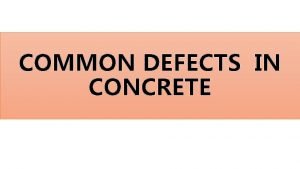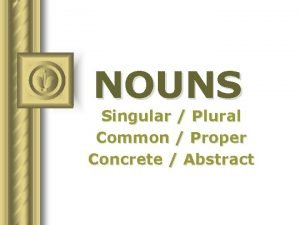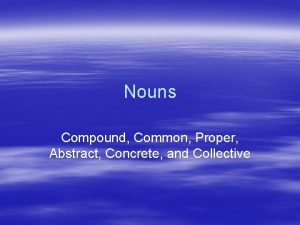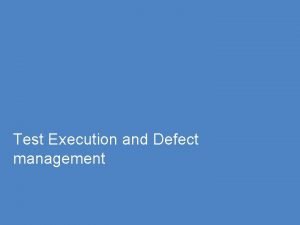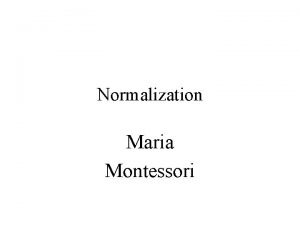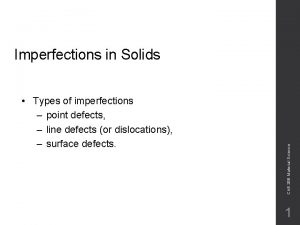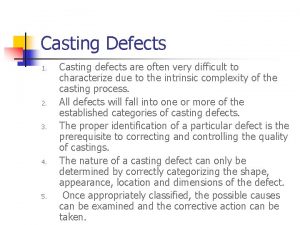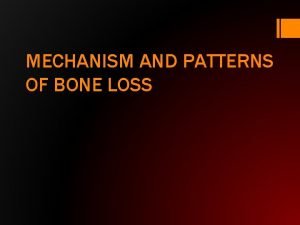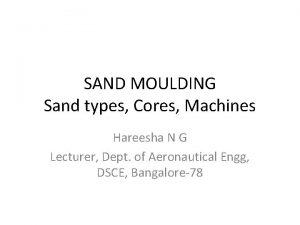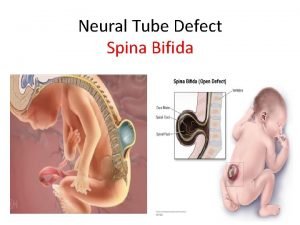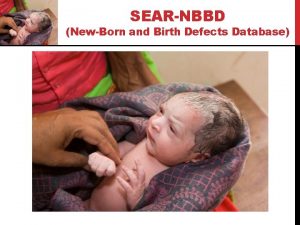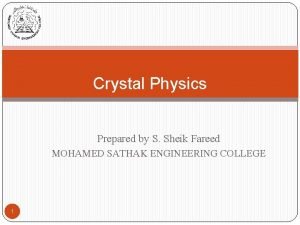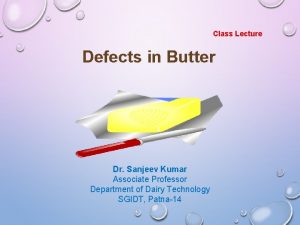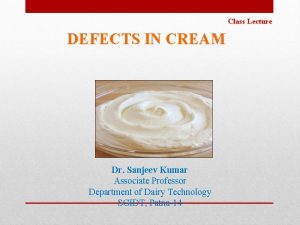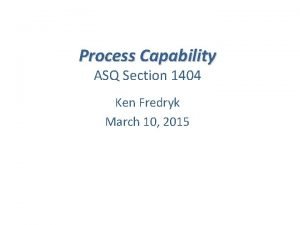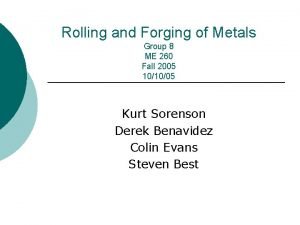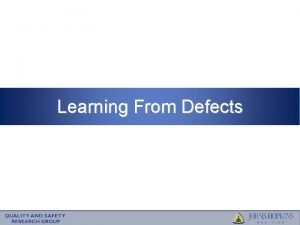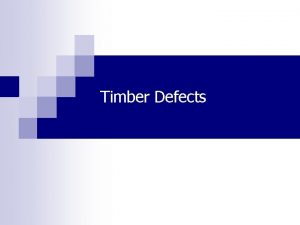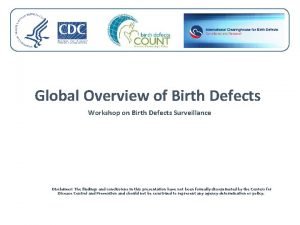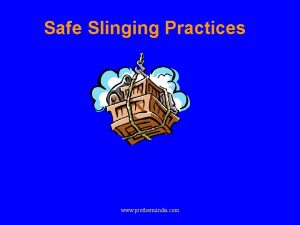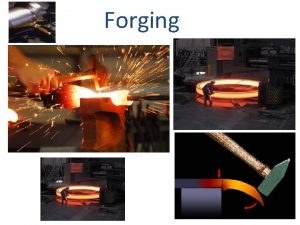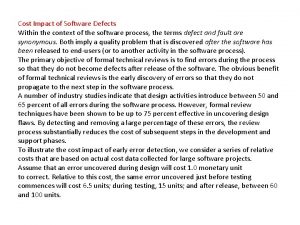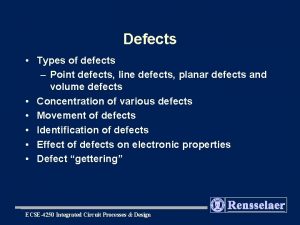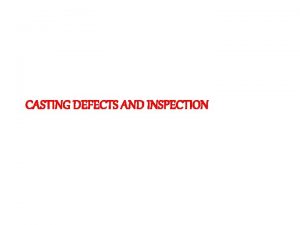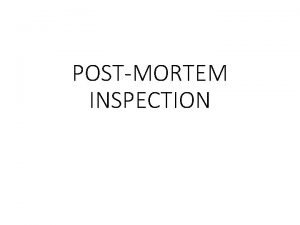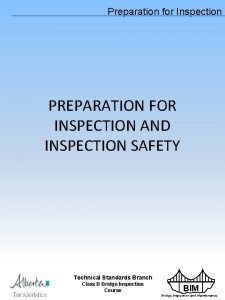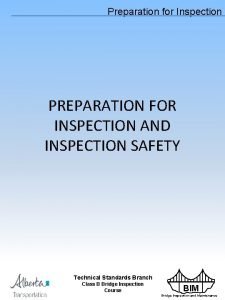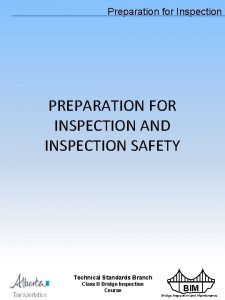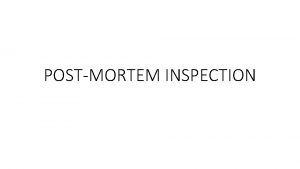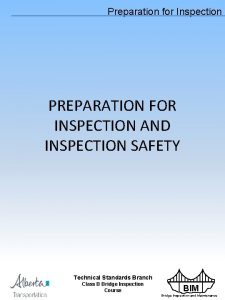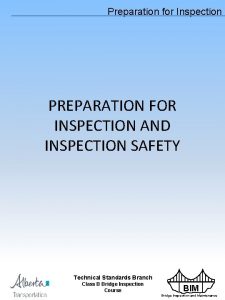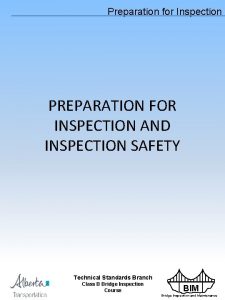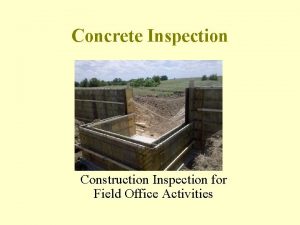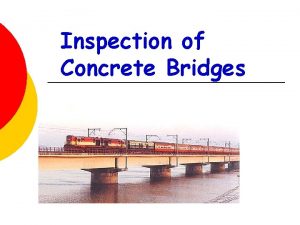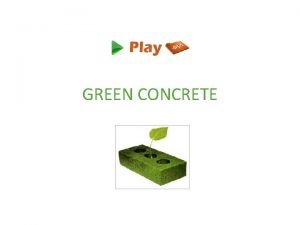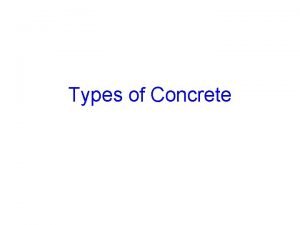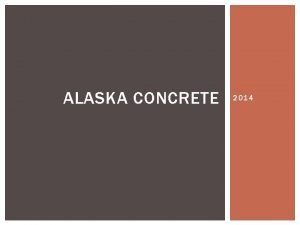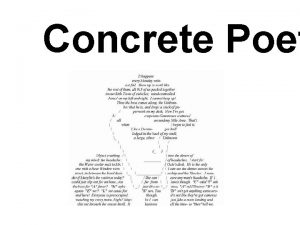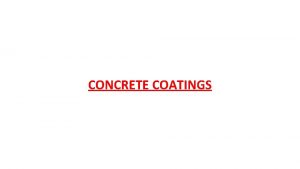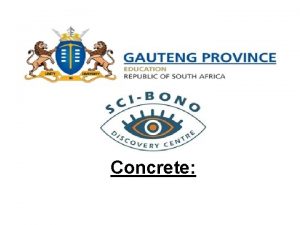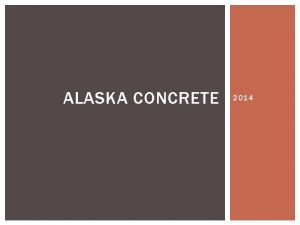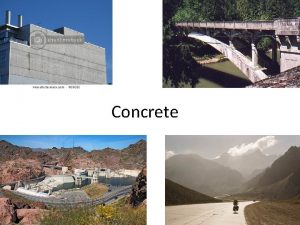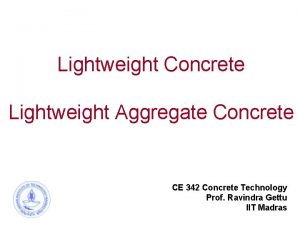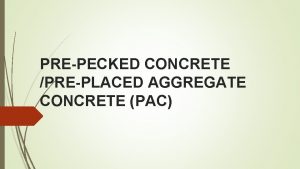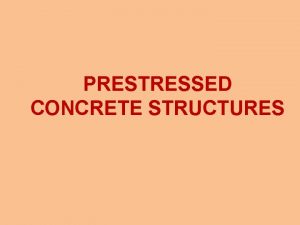COMMON DEFECTS IN CONCRETE Inspection of concrete in





































- Slides: 37

COMMON DEFECTS IN CONCRETE

Inspection of concrete in Service • All concrete structures must be inspected visually immediately after construction and at periodic intervals during service. • Visual inspection provides important historical information on performance , detection of distress and deterioration, enabling repair or rehabilitation before replacement is necessary • It is important that inspector properly documents any observations related to environmental and loading conditions • If need be the visual inspections may be supplemented with nondestructive tests, and other investigations , especially when distress and deterioration is observed and information regarding internal condition of the concrete is needed

Agenda • To understand the causes of various defects in concrete • To learn to do root cause analysis and identify cause of a defect in a given situation • To learn about prevention of concrete defects • To have a glimpse of diagnostic techniques regarding concrete defects • To know about various repair options for various concrete defects

The Need • Long term performance of concrete structure depends upon its being defect free. • Obtaining defect free concrete requires paying attention to all aspects of concrete construction. • Lack of knowledge about defects in concrete and their significance results in inappropriate reengineering actions. • Understanding the root cause of defects , remedial measures and prevention will help us deliver concrete structures with better life cycle costing.

Activity • Make a list of all the defects in the concrete that you can think of. • Try to rank the defects in the order of criticality. We will discuss more discuss defects on priority and at greater length. • I'm confident that some of you will miss some of the defects.

Concrete defects • • • • Honeycomb Cracks General low strength Cold joints Bug holes Efflorescence /leakage Sand streaking Blisters/pop outs Dusting Misalignment (location) General low strength Localised low strength Deviation in Dimensions Out of Plumb Low or high cover • • • • Misalignment (eccentricity) Loss of bond with rebar Unplanned construction joint Offsets at form joints Rebar shadow Foreign material left embedded in concrete Colour variation Damage to edges/broken chunks from concrete High in-situ permeability Spalling of concrete Low density of concrete Bulging Corrosion of rebar ? ? ?

Rebar Shadow

Rebar Shadow

Poor Alignment of Beams

Improper Cover

Improper Cover

Multiple defects in one pour: Rebar location, honeycomb, offset and bug holes!

Multiple defects in one pour: Cold joint, crack & honeycomb!

Crack in web of PSC box girder

Rebar exposed at many location at the soffit

Bursting Cracks in anchorage area

Multiple defects at one location

Vertical crack in side wall of new Box culvert : Identify the cause

Failure of Corbel. NH 2 Jan 2020 : identify the cause

Unplanned Construction Joint

Identify the defect

WATER LEAKAGE/DAMPNESS

WATER LEAKAGE/DAMPNESS

Importance of Defects • Not all defects in the concrete are of equal importance • The defects impact the stability, serviceability, durability and aesthetics of concrete in different manners and to different degree • An understanding of the above will help us to prioritise the defects more effectively

Activity • Take the list of all the defects in concrete that we have listed • Try to categorize the possible impact of each defect type on stability, serviceability, durability and aesthetics of the structures. • The effect can be qualitatively assessed under the following categories: o Yes / Definitely o May be o No /rarely o Depends on other factors

Effect on S. N. Defect Stability Serviceability Durability Appearance 1 Honeycomb May be Yes Definitely 2 Cracks May be Yes definitely Definitely 3 Cold joints No No May be Yes 4 Bug holes No May be No Yes 5 Efflorescence/leakage May be Definitely 6 Sand streaking No No May be Definitely 7 Blisters/pop outs No May be No Yes 8 Dusting No Yes

Effect on S. N. Defect Stability Serviceability Durability Appearance 9 Overall low strength Yes May be Unlikely No 10 Localized low strength Definitely Yes May be No 11 Deviation in dimensions May be No May be 12 Low/high cover May be No Definitely No Likely No No May be Definitely yes No No Definitely May be 13 14 15 Mis-alignment/out of plumb Loss of bond Unplanned construction joint

Effect on S. N. Defect Stability Serviceability Durability Appearance 16 Rebar shadow No No Unlikely Yes 17 Foreign material in concrete May be No 18 Colour variation No No No May be 19 Damage to edges No No No May be 20 High in-situ permeability No May be Definitely No 21 Corrosion, spalling Likely Yes Definitely Yes 22 Bulging No Unlikely No May be

Activity • The following activities are part of concrete production o Mix design o Materials o Mixing o Transportation & placing o Compaction o Curing o Forms Please • Identify which of these activities contribute to each of the listed concrete defects

Contribution of S. N. Defect 1 Honeycomb May be 2 Cracks 3 Mix design Transport & placing (production) Compaction Curing Formwork May be Yes No Definitely Yes No Cold joints Yes Definitely No No 4 Bug holes Yes No May be 5 Efflorescence No No Definitely No No 6 Sand streaking No No No 7 Blisters/pop outs No No May be No No 8 Dusting No No Yes No

Contribution of Mix design Transport & placing (production) Compaction Curing Forms Overall low strength May be Yes Definitely May be No 10 Localized low strength No Yes Definitely May be No 11 Deviation in dimensions No No May be No Definitely 12 Low/high cover No No May be No No 13 Mis-alignment/out of plumb No No Yes S. N. Defect 9 14 Loss of bond Yes Yes No No 15 Unplanned construction joint No Definitely May be No No

Contribution of S. N. Defect 16 Rebar shadow No 17 Foreign material in concrete 18 Mix design Transport & placing (production) Compaction Curing Forms Yes No No Yes Colour variation May be Yes No Likely Yes 19 Damage to edges No Yes No No Yes 20 High in-situ permeability No No Definitely Likely Yes 21 Corrosion, spalling May be Yes Definitely Likely Unlikely 22 Bulging No No May be No Definitely

Time of Occurrence of Defects • The following defects always manifest themselves immediately on removal of the formwork Ø Honeycombs Ø Cold joints/ construction joints Ø Bug holes Ø Sand streaking Ø Out of plumb & alignment Ø Out of place or dimensions Ø Errors in levels Ø Low/high cover, rebar displaced Ø Blisters / pop outs? Ø Time of occurrence of defects Ø If, on removal of the formwork these defects are not seen, they will not occur at a later date Ø Other defects may be seen on removal of formwork or may develop later.

Time of Occurrence of Defects • The following defects will always manifest much later o Corrosion o Spalling o Seepage / efflorescence o Dusting o Blisters o Cracks (non-plastic stage)

Visibility of Defects • The following defects will not be visible at all. These will manifest through other (visible defects) o General low strength o Local low strength o Loss of bond o Low / high cover (except at projecting bars) o Low in-situ permeability o Low density

Documentation of defects • While inspecting a concrete structure, we may come across many defects in the concrete. • Documentation of these defects is important to facilitate cause effect analysis. • In case of cracks, it is important to note size, orientation, location etc. • We may divide the structure in a suitable grid. For example, to document defects in the web of box girder, a horizontal scale at the bottom of the web with points marked at every 1 m interval may be painted. If the depth of the web is more than 2 meter, another horizontal scale at midnight may also be painted. • This system facilitates recording the positional co-ordinates of various defects, especially cracks in a tabular form • These recordings can subsequently be plotted in a graph

Discussion • Defects that are not visible or easy to assess by mere observation are called latent defects • Which type of defect is more serious, the ones that are visible or those that are not? • How can we assure ourselves that there are no latent defect in the structure
 Concrete defects honeycomb
Concrete defects honeycomb Concrete semi concrete abstract
Concrete semi concrete abstract Concrete semi concrete abstract
Concrete semi concrete abstract Proper concrete noun
Proper concrete noun Common proper abstract concrete collective nouns worksheet
Common proper abstract concrete collective nouns worksheet Least common multiple of 12 and 42
Least common multiple of 12 and 42 What is the least common multiple of 18 and 27
What is the least common multiple of 18 and 27 Common anode and common cathode
Common anode and common cathode Highest common factors and lowest common multiples
Highest common factors and lowest common multiples Prime factors of 72
Prime factors of 72 Factors of 54
Factors of 54 Plastic defect
Plastic defect Execution defects
Execution defects Ctc en ctq
Ctc en ctq What are the main defects in montessori method
What are the main defects in montessori method Shell cleanliness shell soundness shell
Shell cleanliness shell soundness shell Types of line defects
Types of line defects Casting defect
Casting defect Rind galls in wood
Rind galls in wood Reverse architecture perio
Reverse architecture perio Open riser and blind riser
Open riser and blind riser Meningocele
Meningocele Birth defects
Birth defects Wire drawing defects
Wire drawing defects Mohamed akel
Mohamed akel Twinning tablet defects
Twinning tablet defects Butter defects
Butter defects Defects in cream
Defects in cream Attribute capability study excel
Attribute capability study excel Hot rolling
Hot rolling Learning from defects tool
Learning from defects tool Honeycombing in timber
Honeycombing in timber Birth defects causes
Birth defects causes Chain sling defects
Chain sling defects Hubbing forging
Hubbing forging The extrusion process
The extrusion process Crystal defects
Crystal defects Defect amplification and removal in software engineering
Defect amplification and removal in software engineering
